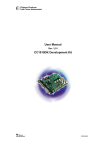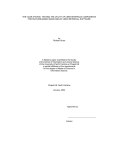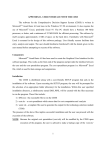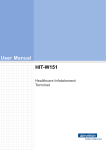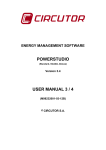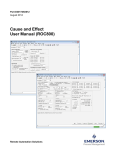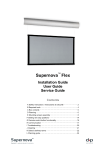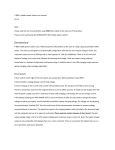Download USER MANUAL
Transcript
Kramer Electronics, Ltd. USER MANUAL Model: VP-727xl Universal Presentation Matrix Switcher / Scaler Contents Contents 1 1.1 2 2.1 3 3.1 4 5 6 7 7.1 7.2 7.3 7.4 8 8.1 8.2 Introduction About the VP-727xl Getting Started Quick Start Overview About HDMI Your VP-727xl Universal Presentation Matrix Switcher / Scaler Installing on a Rack Connecting the VP-727xl Connecting the VP-727xl Control Ports Connecting a PC (via RS-232) Connecting the AUDIO CONTROL Port Connecting via RS-485 Connecting the VP-727xl via the ETHERNET port Understanding the VP-727xl Understanding the UNIVERSAL Inputs Understanding the PREVIEW/PROGRAM Outputs 8.2.1 The Transition from Preview to Program 22 8.3 8.4 Switching/Scaling of an Input Understanding the PIP Button Feature 23 23 8.4.1 8.4.2 8.4.3 Selecting the PIP Source Activating the PIP PIP Characteristics 23 23 24 8.5 8.6 Locking and Unlocking the Front Panel Using Text Overlay 24 24 8.6.1 8.6.2 8.6.3 8.6.4 Downloading the TextOverlay Program Setting the Text Message Connecting and Disconnecting the TextOverlay Program Saving and Loading Settings 27 27 28 29 9 9.1 Operating the VP-727xl Operating via the OSD MENU Screen 29 30 9.1.1 Preview and Program Setting Commands 9.1.1.1 Preview / Program Setting Calibration Screens 9.1.1.2 Preview / Program Setting Output Test Pattern Screens 9.1.1.3 Preview / Program User Mode Output Setting 9.1.2 Transition Commands 9.1.3 Audio Settings Commands 9.1.4 Utility Commands 9.1.4.1 TCP/IP Setting Commands 9.1.4.2 Misc Setting Commands 9.1.4.2.1 Logo 1 1 1 2 3 5 6 11 12 16 16 17 18 19 20 20 21 30 31 33 33 34 35 36 37 38 38 i Contents 9.1.4.2.2 Save Lock 9.1.4.2.3 Input Lock 9.1.4.3 Save/Recall/Erase Setting Commands 9.1.5 Information Screen 38 39 39 39 9.2 9.3 9.4 Operating via the Front Panel LCD Display Operating via the Infra-red Remote Control Transmitter Operating via ETHERNET 39 40 41 9.4.1 9.4.2 9.4.2.1 9.4.3 Installing and Running the Configuration Software Configuring the Ethernet Connection The Configuration Screen Control the VP-727xl via the Ethernet/Serial Port 42 42 42 44 9.5 10 11 12 Operating via RS-232 Technical Specifications VP-727xl Communication Protocol VP-727xl Text Overlay Protocol 45 46 47 55 Figures Figure 1: VP-727xl Universal Presentation Matrix Switcher / Scaler Front Panel Figure 2: VP-727xl Universal Presentation Matrix Switcher / Scaler Rear Panel Figure 3: Connecting the VP-727xl Figure 4: Connecting the INPUTS (an example) Figure 5: Connecting the PREVIEW OUT / PROGRAM OUT Connectors Figure 6: Connecting the PC Figure 7: Connecting the VP-727A to the VP-727xl Figure 8: Connecting the VP-727T to the VP-727xl Figure 9: Example showing the use of the PREVIEW and PROGRAM Output Figure 10: TextOverlay Application Screen Figure 11: Menu Screen Icons Figure 12: Preview and Program Setting OSD Menus Figure 13: Preview Setting Calibration Menu (for HDMI and RGBHV signals) Figure 14: Program Setting Calibration Menu Figure 15: Test Pattern Screens Figure 16: User Mode Setting Figure 17: Transition OSD Figure 18: Audio Setting OSD Figure 19: Utility OSD Figure 20: TCP/IP Setting OSD Figure 21: Misc Setting OSD Figure 22: Information OSD Figure 23: Example of how to use the LCD Display Figure 24: Remote Transmitter Figure 25: VP-727xl Ethernet Application Main Dialog Box (Configuration Tab) Figure 26: VP727xl Control Application Search Panel Screen Figure 27: Configuration Tab Figure 28: Setting an IP Number Figure 29: VP727xl Control Application Main Dialog Box (Control Tab) ii 7 9 13 14 15 16 17 19 22 25 30 30 32 32 33 34 35 36 37 38 38 39 40 41 42 43 43 44 45 KRAMER: SIMPLE CREATIVE TECHNOLOGY Contents Tables Table 1: Front Panel VP-727xl Universal Presentation Matrix Switcher / Scaler Features 8 Table 2: Rear Panel VP-727xl Universal Presentation Matrix Switcher / Scaler Features 10 Table 3: Features and Functions of the TextOverlay Application 25 Table 4: Number of Buffers, Output Resolution and Maximum Display Height 26 Table 5: TextOverlay Parameters 28 Table 6: Preview and Program Setting OSD Menus 30 Table 7: Preview Setting Calibration Menu 32 Table 8: Program Setting Calibration Menu 32 Table 9: User Mode Setting Definitions 34 Table 10: Transition Effect Option Commands 35 Table 11: Audio Setting OSD Menus 36 Table 12: Utility OSD Setting 37 Table 13: TCP/IP Setting OSD 38 Table 14: Remote Transmitter Functions 41 Table 15: VP-727xl Ethernet Application Configuration Tab 42 Table 16: Technical Specifications of the VP-727xl 46 Table 17: Set Commands 48 Table 18: Text Overlay Protocol of the VP-727xl 55 iii Introduction 1 Introduction Welcome to Kramer Electronics! Since 1981, Kramer Electronics has been providing a world of unique, creative, and affordable solutions to the vast range of problems that confront the video, audio, presentation, and broadcasting professional on a daily basis. In recent years, we have redesigned and upgraded most of our line, making the best even better! Our 1,000-plus different models now appear in 11 groups1 that are clearly defined by function. Congratulations on purchasing your Kramer VP-727xl! 1.1 About the VP-727xl The VP-727xl Universal Presentation Matrix Switcher / Scaler is a true multistandard video to graphics scaler and seamless switcher with eight universal inputs comprised of five BNC connectors each of which can accommodate a composite video, s-Video (Y/C), component video (RGB/YUV), RGBS, or RGBHV signal. Input 1 and input 2 also accommodate HDMI inputs. It has dual scalers, one for the preview and the other for the program output. Dual scalers are required to do "live" seamless transitions from one source to another. It is ideal for these typical applications: Presentation applications that require a preview option Projection systems in conference rooms, board rooms, auditoriums, hotels, and churches Presentations requiring seamless switching between inputs, using special effects, cuts and fades The package includes these items: VP-727xl Universal Presentation Matrix Switcher / Scaler, power cord2, infrared remote control transmitter (including the required battery), null-modem adapter, and this user manual3. 2 Getting Started We recommend that you: Unpack the equipment carefully and save the original box and packaging materials for possible future shipment Review the contents of this user manual Use Kramer high performance high resolution cables4 1 GROUP 1: Distribution Amplifiers; GROUP 2: Switchers and Matrix Switchers; GROUP 3: Control Systems; GROUP 4: Format/Standards Converters; GROUP 5: Range Extenders and Repeaters; GROUP 6: Specialty AV Products; GROUP 7: Scan Converters and Scalers; GROUP 8: Cables and Connectors; GROUP 9: Room Connectivity; GROUP 10: Accessories and Rack Adapters; GROUP 11: Sierra Products 2 We recommend that you use only the power cord that is supplied with the machine 3 Download up-to-date Kramer user manuals from the Internet at this URL: http://www.kramerelectronics.com 4 The complete list of Kramer cables is on our Web site at http://www.kramerelectronics.com 1 Getting Started 2.1 Quick Start This quick start chart summarizes the basic steps when connecting a VP-727xl: 2 KRAMER: SIMPLE CREATIVE TECHNOLOGY Overview 3 Overview The VP-727xl Universal Presentation Matrix Switcher / Scaler is a true multi-standard video to graphics scaler and presentation switcher for a wide variety of presentation and multimedia applications. It consists of a very high quality scaler with many user-selectable pixel-rates including VGA (640x480), SVGA (800x600), 832x624, 852x480, XGA (1024x768), 1280x720, 1280x768, SXGA (1280x1024), 1366x768, 1365x1024, 1400x1050, UXGA (1600x1200), and high definition television HDTV: 480p, 576p, 720p, 1080i, and 1080p, as well as a user definable output mode1. The VP-727A Audio Switcher is an audio companion switcher for the VP-727xl, and operates in conjunction with it and the VP-727T Presentation Switcher Control Panel. In particular, the VP-727xl: Features eight sets of universal INPUT BNC connectors: R/PR, G/Y/CV, B/PB/C, HS/CS, and VS. Each set can be programmed to operate as: composite video, s-Video, component video2, RGsB/YUV, RGBS, or RGBHV Includes two HDMI inputs (for input 1 and input 2) that support up to 1.65Gbps bandwidth per graphic channel3 Supports HDCP (High Definition Digital Content Protection) Scales the selected sources to HDMI, RGBHV (Y, Pb, Pr) and VGA outputs simultaneously Has dual scalers—for “live” seamless transitions from one source to another—with two independent outputs: a PREVIEW OUT and a PROGRAM OUT (see section 8.2). The PREVIEW output—including an OSD menu for making adjustments—is for determining how the scaled output will look before displaying live during a presentation, as well as for setting the special effects that harmonize the transition when changing between sources. Both outputs have separate sets of connectors for HDMI, VGA (a 15-pin HD computer graphics video connector), and RGBHV / YPbPr (on BNC connectors) Features eight PREVIEW input buttons for switching a selected input to the PREVIEW output and 8 PROGRAM input buttons for switching a selected input to the PROGRAM output 1 Recommended for advanced users only – non-standard settings may not be recognized by the display device 2 Sometimes called YUV, or Y, B-Y, R-Y, or Y, Pb, Pr. The component input type (HDTV or YCbCr) may be set as HD or SD 3 Suitable for resolutions up to UXGA at 60Hz, and for all HD resolutions 3 Overview Includes two transition modes (accessible via the OSD): the Swap mode and the Follow mode. When pressing the TAKE button in the Swap mode, the preview and program inputs switch positions; when pressing in the Follow mode, the program input follows the preview input Scales and zooms (to up to 400% of the original size) Offers high quality de-interlacing 3:2/2:2 pull down1 Has a text overlay feature for easy insertion of subtitles, karaoke script, and text banners Has built-in Picture-In-Picture inserters for both the PREVIEW and the PROGRAM outputs, letting you insert a video source into a graphics background or vice versa. This PIP image may be positioned and sized anywhere on the screen, or displayed as two images side by side (Split Screen) Saves all settings in non-volatile memory in the unit Supports firmware upgrade via RS 232 Features a sophisticated front panel lockout2 Features a Take button for executing preview to program switching (with transition effects, which include cuts, fades, and wipes3) Has ProcAmp4 controls for both outputs Has multi-standard video support: PAL, SECAM, and NTSC (3.58/4.43) Has a built-in Time Base Corrector that stabilizes video sources with unstable sync Features multiple color space, outputting RGB or YUV (selectable) Digitally reprocesses the signal to correct mastering errors, and regenerates the video at a chosen line and pixel rate format, providing, for example, native-resolution video for LCD, DLP and Plasma displays Facilitates scaling of graphics resolutions to other resolutions Incorporates a unique graphics-scaling engine with image enhancement algorithms, which are built into the firmware Is specifically designed to improve video quality by reducing chroma noise Comes in a rugged, professional 19" 3U rack-mountable metal enclosure Uses a universal 100-240VAC automatic power supply 1 Accommodates the frame-rate of a converted movie (24 frames per second) to video frequencies (25 frames per second (PAL); 30 frames per second (NTSC) 2 See sections 8.5 and 9.1.4.2 3 The wipe can be from left to right, right to left, up or down, and the corner wipe can start from any corner. The speed of each transition can be adjusted 4 Processing amplification enables adjustment of different video and audio signal parameters 4 KRAMER: SIMPLE CREATIVE TECHNOLOGY Overview Control the VP-727xl via the: Front panel user-friendly menu-driven OSD (see section 9.1) High contrast LCD Display (see section 9.2) IR remote control transmitter (see section 9.3) ETHERNET (see section 9.4) RS-232 (see section 9.5) Kramer VP-727T Presentation Switcher Control Panel1 3.1 About HDMI High-Definition Multimedia Interface (HDMI) is an uncompressed all-digital2 audio/video interface, widely supported in the entertainment and home cinema industry. It delivers the highest high-definition image and sound quality. Note that Kramer Electronics Limited is an HDMI Adopter3 and an HDCP Licensee4. In particular, HDMI5: Provides a simple6 interface between any audio/video source, such as a set-top box, DVD player, or A/V receiver and video monitor, such as a digital flat LCD / plasma television (DTV), over a single lengthy7 cable Supports standard, enhanced, high-definition video, and multi-channel digital audio8 on a single cable Transmits all ATSC HDTV standards and supports 8-channel digital audio, with bandwidth to spare to accommodate future enhancements and requirements Benefits consumers by providing superior, uncompressed digital video quality via a single cable9, and user-friendly connector Is backward-compatible with DVI (Digital Visual Interface) 1 See the separate user manual on our Web site at http://www.kramerelectronics.com 2 Ensuring an all-digital rendering of video without the losses associated with analog interfaces and their unnecessary digitalto-analog conversions 3 See http://www.hdmi.org/about/adopters_founders.asp 4 See http://www.digital-cp.com/list/ 5 HDMI, the HDMI logo and High-Definition Multimedia Interface are trademarks or registered trademarks of HDMI licensing LLC 6 With video and multi-channel audio combined into a single cable, the cost, complexity, and confusion of multiple cables currently used in A/V systems is reduced 7 HDMI technology has been designed to use standard copper cable construction at up to 15m 8 HDMI supports multiple audio formats, from standard stereo to multi-channel surround-sound. HDMI has the capacity to support Dolby 5.1 audio and high-resolution audio formats 9 HDMI provides the quality and functionality of a digital interface while also supporting uncompressed video formats in a simple, cost-effective manner 5 Your VP-727xl Universal Presentation Matrix Switcher / Scaler Supports two-way communication between the video source (such as a DVD player) and the digital television, enabling new functionality such as automatic configuration and one-button play HDMI has the capacity to support existing high-definition video formats (720p, 1080i, and 1080p/60), standard definition formats such as NTSC or PAL, as well as 480p and 576p. Achieving the best performance means: Connecting only good quality connection cables, thus avoiding interference, deterioration in signal quality due to poor matching, and elevated noise levels (often associated with low quality cables) Avoiding interference from neighboring electrical appliances, making sure not to block the ventilation holes, and positioning your VP-727xl away from moisture, excessive sunlight and dust 4 Your VP-727xl Universal Presentation Matrix Switcher / Scaler Figure 1 and Table 1 define the front panel of the VP-727xl: 6 KRAMER: SIMPLE CREATIVE TECHNOLOGY Figure 1: VP-727xl Universal Presentation Matrix Switcher / Scaler Front Panel Your VP-727xl Universal Presentation Matrix Switcher / Scaler 7 Your VP-727xl Universal Presentation Matrix Switcher / Scaler Table 1: Front Panel VP-727xl Universal Presentation Matrix Switcher / Scaler Features # Feature Function POWER Switch Illuminated switch for turning the unit ON or OFF 2 IR Receiver / LED Green when ON; red when OFF1 4 5 6 7 8 9 10 PROGRAM Buttons 3 PREVIEW Buttons 1 INPUTS Selects one of the R/PR, G/Y/CV, B/PB/C, HS/CS, VS sources (from 1 to 8)2 PIP Toggles the picture-in-picture function on and off BLANK Toggles between a blank screen and the selected input FREEZE Freezes the output video image (toggle) INPUTS Selects one of the sources: R/PR, G/Y/CV, B/PB/C, HS/CS, VS (from 1 to 8) FREEZE Freezes the output video image (toggle) BLANK PIP Toggles between a blank screen and the selected input Toggles the picture-in-picture function on and off 3 11 TAKE Button 8 13 14 15 16 17 18 TRANSITION Buttons 3,4 12 FADE Button 19 CUT 8 Button DIRECTION Buttons 20 OSD Button 21 22 23 24 25 ENTER Button Pressing TAKE causes the transition to occur Selects a dissolved transition from the PREVIEW output to the PROGRAM output 5 Selects a WIPE transition effect 7 Selects a SQUARE transition effect 7 Selects a CHESSBOARD transition effect 6 Selects a DIAGONAL transition effect Selects a CIRCLE transition effect7 Selects a CORNER transition effect6 Selects an instantaneous transition from the PREVIEW output to the PROGRAM output Activates/deactivates access to the OSD Menu Toggles within each level 2 command / increases the range by one step Moves up one step (in the same level) in the OSD menu Moves down one step (in the same level) in the OSD menu Toggles within each level 2 command / decreases the range by one step Moves to the next level in the OSD menu 26 MENU Button Displays the OSD Menu screen (or moves to the previous level in the OSD menu) 27 LCD STATUS Display Displays the status of the unit, and is used for menu navigation 28 PANEL LOCK Button Locks/unlocks the front panel Figure 2 and Table 2 define the rear panel of the VP-727xl: 1 OFF in this case means that the outputs and the front-panel are disabled 2 The INPUT buttons 1 and 2 also select the HDMI sources 1 and 2, respectively 3 The effect is only seen in PROGRAM Mode. The PREVIEW screen will blank during the transition 4 Select a specific effect for the transition from the PREVIEW output to the PROGRAM output 5 Choose the direction from where the effect starts: “left to right”, “right to left”, “up” or “down” (see section 9.1.2) 6 Choose the direction from where the effect starts: “top left”, “bottom left”, “top right” or “bottom right” (see section 9.1.2) 7 Choose the direction from where the effect starts: “in” or “out” (see section 9.1.2) 8 Only for setting up the unit for the effect. The effect will only occur when the Take button is pressed 8 KRAMER: SIMPLE CREATIVE TECHNOLOGY Your VP-727xl Universal Presentation Matrix Switcher / Scaler Figure 2: VP-727xl Universal Presentation Matrix Switcher / Scaler Rear Panel 9 Your VP-727xl Universal Presentation Matrix Switcher / Scaler Table 2: Rear Panel VP-727xl Universal Presentation Matrix Switcher / Scaler Features # Feature Function PROGRAM OUT Connects to the PROGRAM display device (component video1 or RGB or RGBHV acceptor) PREVIEW OUT 1 B/PB BNC Connector 2 G/Y BNC Connector 3 R/PR BNC Connector 4 VS BNC Connector 5 HS BNC Connector 6 R/PR BNC Connector 7 G/Y BNC Connector 8 B/PB BNC Connector 9 HS BNC Connector 10 VS BNC Connector 11 Power Connector with FUSE 12 RS-232 9-pin D-sub Connector 13 RS-485 Port Connects to the PREVIEW display device (component video1 or RGB or RGBHV acceptor) 14 ETHERNET Port 15 AUDIO CONTROL Port 16 PREVIEW OUT VGA 15-pin HD Connector HDMI Connector Connects to an HDMI acceptor PROGRAM OUT VGA 15-pin HD Connector Connects to a VGA (analog interface) graphics acceptor HDMI Connector Connects to an HDMI acceptor 17 18 AC connector enabling power supply to the unit Connects to PC or Serial Controller Connects to the Kramer VP-727T Presentation Switcher Control 2 Panel (optional). Pin G is for the Ground connection ; pins B (-) and A (+) are for RS-485 Connects to your LAN3 Connects to the Kramer VP-727A Audio Switcher (optional). Pin G is 2 for the Ground connection ; pins B (-) and A (+) are for RS-485 19 Connects to a VGA (analog interface) graphics acceptor INPUTS (from 1 to 8) R/PR BNC Connector Connects to the RGB, RGBHV, RGBS, or component video1 source G/Y/CV BNC Connector Connects to the RGB, RGBHV, RGBS, component video1, composite video, or s-Video4 source 22 B/PB/C BNC Connector Connects to the RGB, RGBHV, RGBS, component video1 or s-Video4 source 23 HS/CS BNC Connector Connects to the RGBHV or RGBS source 24 VS BNC Connector Connects to the RGBHV source 25 INPUTS HDMI 2 Connector Connect to the HDMI 2 source 26 HDMI 1 Connector Connect to the HDMI 1 source 20 21 1 Sometimes called YUV; Y, B-Y, R-Y; Y, Pb, Pr; or Y, Cb, Cr 2 The ground connection is sometimes connected to the shield of the RS-485 cable. In most applications, the ground is not connected 3 Local Area Network (that is, computers sharing a common communications line or wireless link, which often share a server within a defined geographic area) 4 Made up of the Y on the G/Y/CV connector together with the C on the B/Pb/C connector 10 KRAMER: SIMPLE CREATIVE TECHNOLOGY Installing on a Rack 5 Installing on a Rack This section describes what to do before installing in a rack and how to rack mount. Before Installing in a Rack Before installing in a rack, be sure that the environment is within the recommended range: Operating temperature range +5° to +45° C (41° to 113° F) Operating humidity range 10 to 90% RHL, non-condensing Storage temperature range -20° to +70° C (-4° to 158° F) Storage humidity range 5 to 95% RHL, non-condensing How to Rack Mount To rack-mount a machine: 1. Attach both ear brackets to the machine. To do so, remove the screws from each side of the machine (3 on each side), and replace those screws through the ear brackets. CAUTION!! When installing on a 19" rack, avoid hazards by taking care that: 1. It is located within the recommended environmental conditions, as the operating ambient temperature of a closed or multi unit rack assembly may exceed the room ambient temperature. 2. Once rack mounted, enough air will still flow around the machine. 3. The machine is placed straight in the correct horizontal position. 4. You do not overload the circuit(s). When connecting the machine to the supply circuit, overloading the circuits might have a detrimental effect on overcurrent protection and supply wiring. Refer to the appropriate nameplate ratings for information. For example, for fuse replacement, see the value printed on the product label. 5. The machine is earthed (grounded) in a reliable way and is connected only to an electricity socket with grounding. Pay particular attention to situations where electricity is supplied indirectly (when the power cord is not plugged directly into the socket in the wall), for example, when using an extension cable or a power strip, and that you use only the power cord that is supplied with the machine. 2. Place the ears of the machine against the rack rails, and insert the proper screws (not provided) through each of the four holes in the rack ears. Note that: In some models, the front panel may feature built-in rack ears Detachable rack ears can be removed for desktop use Always mount the machine in the rack before you attach any cables or connect the machine to the power If you are using a Kramer rack adapter kit (for a machine that is not 19"), see the Rack Adapters user manual for installation instructions (you can download it at: http://www.kramerelectronics.com) 11 Connecting the VP-727xl 6 Connecting the VP-727xl The VP-727xl is a universal presentation matrix switcher / scaler that lets you choose what sources to connect to the inputs. For example, you can connect just four sources: an RGBHV source, an HDMI source, an HDTV source and an RGBS source (as the example in Figure 3 shows). To connect1 the VP-727xl as illustrated in the example in Figure 3, do the following: 1. Connect the following video sources: An RGBHV (high resolution) computer graphics source to the R/PR, G/Y/CV, B/PB/C, HS/CS and VS BNC INPUT 1 connectors An HDMI source to the INPUT HDMI 2 connector An HDTV satellite receiver source to the R/PR, G/Y/CV, and B/PB/C BNC INPUT 6 connectors An RGBS (separate composite sync) computer graphics source to the R/PR, G/Y/CV, B/PB/C, and HS/CS BNC INPUT 8 connectors 2. Connect the PROGRAM OUT: HDMI connector to the plasma display VGA HD15F connector to the analog display R/PR, G/Y, B/PB, (PR, Y, PB) BNC OUTPUT connectors to the YUV acceptor, for example, a projector 3. Connect the PREVIEW OUT R/PR, G/Y, B/PB, HS and VS BNC OUTPUT connectors to the display 4. Connect the power cord2. 5. If required, connect: A PC via RS-232, see section 7.1 The Kramer VP-727A Audio Switcher via the AUDIO CONTROL port, see section 7.2 The Kramer VP-727T Presentation Switcher Control Panel via the RS-485 port, see section 7.3 The ETHERNET port, see section 7.4 1 Switch OFF the power on each device before connecting it to your VP-727xl. After connecting your VP-727xl, switch on its power and then switch on the power on each device 2 We recommend that you use only the power cord that is supplied with this machine 12 KRAMER: SIMPLE CREATIVE TECHNOLOGY Connecting the VP-727xl Figure 3: Connecting the VP-727xl Figure 4 shows an example of how to connect1 8 sources to the rear panel of the VP-727xl: an RGBHV source, an HDMI source, a CV source, a Y/C source, a component video source, an HDTV source, an RGBCs source and an RGB source. To connect2 the VP-727xl, as illustrated in the example in Figure 4, do the following3: 1. Connect the following video sources2 (see Figure 4): An RGBHV (high resolution) computer graphics source to the R/PR, G/Y/CV, B/PB/C, HS/CS and VS BNC INPUT 1 connectors 1 Figure 4 and Figure 5 show how to connect several sources, and the PREVIEW/PROGRAM OUT connectors, respectively 2 As this particular example describes. As the VP-727xl is universal, you can connect any type (format) of video to the inputs 3 Switch OFF the power on each device before connecting it to your VP-727xl. After connecting your VP-727xl, switch on its power and then switch on the power on each device 13 Connecting the VP-727xl An HDMI source to the INPUT HDMI 2 connector A set top box to the G/Y/CV BNC INPUT 3 connector A DVD player to the G/Y/CV and B/PB/C BNC INPUT 4 connectors A component source—for example, a Betacam video player—to the R/PR, G/Y/CV, and B/PB/C BNC INPUT 5 connectors An HDTV satellite receiver source to the R/PR, G/Y/CV, and B/PB/C BNC INPUT 6 connectors An RGBCs (separate composite sync) computer graphics source to the R/PR, G/Y/CV, B/PB/C, and HS/CS BNC INPUT 7 connectors An RGB camera to the R/PR, G/Y/CV, and B/PB/C BNC INPUT 8 connectors PR PR R R Y Y Y G G C PB PB B B R G CV B Cs Hs Vs Set Top Box Source RGBHV (High Resolution) Computer Graphics Source DVD Player RGB Camera Betacam Video Player RGBS (Separate Composite Sync) Computer Graphics Source DVD Player HDTV Satellite Receiver Source Figure 4: Connecting the INPUTS (an example) 2. Connect the PROGRAM OUT (see Figure 5): R/PR, G/Y, B/PB, (PR, Y, PB) BNC OUTPUT connectors to the YUV acceptor, for example, a projector HDMI connector to a plasma display 14 KRAMER: SIMPLE CREATIVE TECHNOLOGY Connecting the VP-727xl VGA a 15-pin HD computer graphics video connector to an analog display 3. Connect the PREVIEW OUT (see Figure 5): HDMI connector to an LCD display VGA 15-pin HD computer graphics video connector to an analog display R/PR, G/Y, B/PB, HS and VS BNC OUTPUT connectors to a display Plasma Display Figure 5: Connecting the PREVIEW OUT / PROGRAM OUT Connectors 4. Connect the power cord1. 5. If required, connect: A PC via RS-232, see section 7.1 The Kramer VP-727A Audio Switcher via the AUDIO CONTROL port, see section 7.2 The Kramer VP-727T Presentation Switcher Control Panel via the RS-485 port, see section 7.3 The ETHERNET port, see section 7.4 1 We recommend that you use only the power cord that is supplied with this machine 15 Connecting the VP-727xl Control Ports 7 Connecting the VP-727xl Control Ports This section describes how to connect the VP-727xl control ports, that is, the: RS-232 port, see section 7.1 AUDIO CONTROL port, see section 7.2 RS-485 port, see section 7.3 ETHERNET port, see section 7.4 7.1 Connecting a PC (via RS-232) You can connect a PC (or other controller) to the VP-727xl via the RS-232 port for remote control, and for upgrading the firmware. To connect a PC to a VP-727xl unit, using the Null-modem adapter provided with the machine (recommended): Connect the RS-232 9-pin D-sub rear panel port on the VP-727xl unit to the Null-modem adapter and connect the Null-modem adapter with a 9 wire flat cable to the RS-232 9-pin D-sub port on your PC To connect a PC to a VP-727xl unit, without using a Null-modem adapter: Connect the RS-232 9-pin D-sub port on your PC to the RS-232 9-pin D-sub rear panel port on the VP-727xl unit, forming a cross-connection1, as Figure 6 illustrates DB9 (FromPC) DB9 (To Presentation Switcher / Scaler) Figure 6: Connecting the PC 1 Also known as a Null-modem connection 16 KRAMER: SIMPLE CREATIVE TECHNOLOGY Connecting the VP-727xl Control Ports 7.2 Connecting the AUDIO CONTROL Port The Kramer VP-727A Audio Switcher operates in conjunction with the VP-727xl. When connected, the audio switcher signals follow the video signals1. To connect the VP-727xl to the Kramer VP-727A Audio Switcher via the AUDIO CONTROL RS-485 port, as illustrated in the example in Figure 7, do the following: Connect the “ A” (+) PIN on the AUDIO CONTROL RS-485 rear panel port of the VP-727xl to the A (+) PIN on the RS-485 rear panel port of the VP-727A unit Connect the “ B” (-) PIN on the AUDIO CONTROL RS-485 rear panel port of the VP-727xl to the B (-) PIN on the RS-485 rear panel port of the VP-727A unit If shielded twisted pair cable is used, the shield may be connected to the “ G” (Ground) PIN on one of the units Figure 7: Connecting the VP-727A to the VP-727xl 1 See the separate VP-727A user manual on our Web site at http://www.kramerelectronics.com 17 Connecting the VP-727xl Control Ports 7.3 Connecting via RS-485 To connect the VP-727xl to the Kramer VP-727T Presentation Switcher Control Panel1 via the RS-485 control port, as illustrated in Figure 8, do the following: Connect the “ A” (+) PIN on the RS-485 rear panel port of the VP-727xl to the A (+) PIN on the RS-485 rear panel port of the VP-727T unit Connect the “ B” (-) PIN on the RS-485 rear panel port of the VP-727xl to the B (-) PIN on the RS-485 rear panel port of the VP-727T unit If shielded twisted pair cable is used, the shield may be connected to the “ G” (Ground) PIN on one of the units Figure 8: Connecting the VP-727T to the VP-727xl 1 See the separate VP-727T user manual on our Web site at http://www.kramerelectronics.com 18 KRAMER: SIMPLE CREATIVE TECHNOLOGY Connecting the VP-727xl Control Ports 7.4 Connecting the VP-727xl via the ETHERNET port To connect the VP-727xl via the ETHERNET port, do the following: Connect the ETHERNET port of the VP-727xl to the LAN port of your PC, via a crossover cable with RJ-45 connectors. If connecting the ETHERNET port of the VP-727xl to the LAN port on a network hub or network router, use a straight-through cable with RJ-45 connectors. 19 Understanding the VP-727xl 8 Understanding the VP-727xl This section describes the: UNIVERSAL inputs, see section 8.1 PREVIEW/PROGRAM outputs, see section 8.2 Switching/Scaling of an input, see section 8.3 PIP feature, see section 8.4 Panel Lock, see section 8.5 8.1 Understanding the UNIVERSAL Inputs The VP-727xl has eight sets of inputs1; each set can be programmed to operate as composite video, s-Video, component video, RGB/YUV, RGBS, RGsB, or RGBHV. INPUT 1 and INPUT 2 can also accept HDMI inputs. The VP-727xl is a universal presentation matrix switcher / scaler: you choose what type of source to connect to each input. You can connect different video types or the same or similar video types. See the examples in Figure 3 and Figure 4 in section 6. 8.2 Understanding the PREVIEW/PROGRAM Outputs The VP-727xl has two outputs: a PREVIEW output, and a PROGRAM output. Each of these outputs functions independently and has HDMI connectors and VGA connectors, as well as sets of five BNC connectors2: R/PR, G/Y, B/PB, HS, and VS. The HDMI signal is usually HDCP protected. It is therefore recommended to use a display that is HDCP compliant, otherwise the HDMI output will not appear on the screen Using the PREVIEW output, you can: See how the scaled output will look before displaying live during a presentation. As the example in Figure 9 illustrates, after seeing how the RGB source looks when scaled to HDMI, it can be interchanged with the YUV source, seamlessly, using an elaborate (in this case chessboard) transition effect Harmonize transition to the PROGRAM output after determining the look and feel when in the PREVIEW output Use the OSD menu to make adjustments and choose the settings Set the transition, choosing one of any eight special effects 1 Each set consists of 5 BNC connectors: R/Pr, G/Y/CV, B/Pb/C, Hs/Cs, and Vs 2 Used to output one of the following: RGB, RGBHV, or component video 20 KRAMER: SIMPLE CREATIVE TECHNOLOGY Understanding the VP-727xl Using the PROGRAM output, after pressing the TAKE button, you can see the transition1. 1. In this example an RGBS source is connected to input 2, and an HD Component source is connected to input 3. Set the OSD Settings as follows: The PROGRAM INPUT button 3 and the PREVIEW INPUT button 2 illuminate: 2. During the presentation, the HD Component source is outputted via the HDMI PROGRAM OUT connector. Before changing to the RGBS source, the demonstrator previews how that source currently looks on his local Plasma Display 3. Pressing the Chessboard button and then the TAKE button causes the transition to occur. The PROGRAM INPUT button 2 illuminates to correspond with the PREVIEW INPUT button 2. The RGBS source is displayed on both the PREVIEW and PROGRAM screens: Plasma Display Figure 9: Example showing the use of the PREVIEW and PROGRAM Output 1 After making some changes in the unit (for example, selecting a new input to the PREVIEW output), the TAKE button will be turned off (not illuminated) momentarily (until the unit successfully locks to this input). The TAKE button should not be pressed until it lights up again, otherwise there will be a period of black during the transition 21 Understanding the VP-727xl 8.2.1 The Transition from Preview to Program The transition can occur in one of two modes1: The Follow mode (shown in Figure 9) in which the PROGRAM input button is switched to the same position as the PREVIEW input button after the TAKE button is pressed The Swap mode, in which the PREVIEW input buttons and the PROGRAM input buttons switch places after pressing the TAKE button. For example, in Figure 9 the PROGRAM input button 3 would switch to 2 and the PREVIEW input button 2 would switch to 3, so the RGBS source is displayed on the PROGRAM screen and the HD Component source is displayed on the PREVIEW screen. 8.3 Switching/Scaling of an Input The VP-727xl scales the selected sources2 to HDMI, RGBHV or YUV and VGA simultaneously. It switches seamlessly between sources using the selected special effects, which include cuts, fades, and wipes. Select the appropriate source (from channel 1 to 8) via the Input command in both the Preview Setting OSD screen and/or the Program Setting OSD screen (see section 9.1.1), via the IR or front panel pushbuttons, or via the serial or Ethernet control. 8.4 Understanding the PIP Button Feature The Picture-in-Picture inserter (PIP) is used for the simultaneous display of video and graphic sources3, and lets you display an inserted video PIP source over a graphic source4, or an inserted graphic PIP source over a video source5. 8.4.1 Selecting the PIP Source Select the PIP source (from channel 1 to 8), via the PIP source command in both the Preview Setting OSD screen and/or the Program Setting OSD screen. 1 As selected via the Transition OSD Menu, see section 9.1.2 2 Composite video, s-Video, component video (sometimes called YUV or Y, B-Y, R-Y or Y, Pb, Pr ), RGB/YUV, RGBS, RGsB, or RGBHV 3 Since the HDMI signal is HDCP protected, an HDMI signal cannot appear on a display that is not HDCP compliant 4 For example, a composite video, s-Video, or component (video) video PIP source inserted over a component (graphics), RGB/YUV, RGBS, RGsB, or RGBHV graphic source 5 For example, a component (graphics), RGB/YUV, RGBS, RGsB, or RGBHV graphic PIP source inserted over a composite video, s-Video, or component (video) video source 22 KRAMER: SIMPLE CREATIVE TECHNOLOGY Understanding the VP-727xl 8.4.2 Activating the PIP To activate the PIP (which illuminates the PIP button), do one of the following: Press the PIP button Switch on the PIP functionality via the OSD Menu Press the PIP key on the remote control transmitter (see Figure 24) Select PIP via the serial or the Ethernet port 8.4.3 PIP Characteristics You can determine the following PIP characteristics: PIP Source PIP Size (1/25, 1/16, 1/9, 1/4, split screen, or custom1). Via the Preview Setting PIP OSD menu, you can resize the PIP Horizontal and Vertical position, placing it anywhere on the screen. To move the location of the PIP, reset the PIP position in the Preview Setting PIP OSD menu You set the custom PIP size via the H-Size and V-Size settings in the Preview Setting PIP OSD menu 8.5 Locking and Unlocking the Front Panel To prevent changing the settings accidentally or tampering with the unit via the front panel buttons, lock your VP-727xl. Unlocking releases the protection mechanism. When the front panel is locked, control is still available via RS-232, the ETHERNET, and/or the CONTROL connector. To lock the VP-727xl: Press and hold for a few seconds the PANEL LOCK button2 on the front panel The front panel is locked and the PANEL LOCK button is illuminated. Pressing a button will have no effect To unlock the VP-727xl: Press and hold for a few seconds the illuminated PANEL LOCK button2 on the front panel The front panel unlocks and the PANEL LOCK button is no longer illuminated For a description of the Save Lock and Input Lock OSD functions, see section 9.1.4.2. 1 You set the custom PIP size via the H-Size and V-Size settings in the Preview Setting PIP OSD menu 2 Or the Lock key on the infra-red remote control transmitter (see Figure 24) 23 Understanding the VP-727xl 8.6 Using Text Overlay The text overlay feature is accessed via the Application Program (AP)1. Running this AP with the PC connected to the VP-727xl lets you display text over the screen, with a rich feature set including text color and speed, transparency, text position and repetition. Current text overlay settings can be saved and loaded to the AP. Before running this program, you have to close the Ethernet Application program. Figure 10 and Table 3 define the TextOverlay Application Screen: Figure 10: TextOverlay Application Screen 1 You can download it from our Web site: http://www.kramerelectronics.com 24 KRAMER: SIMPLE CREATIVE TECHNOLOGY Understanding the VP-727xl Table 3: Features and Functions of the TextOverlay Application 1 Feature Background Color # Normal Color Effect Scrolling Mode Text Color 4 Partial Transparency 1 2 3 Function Effect1 Partial Transparency Normal Color Blank Time Speed Mode Number of Accessible Buffers Display Height 6 7 Text Position – V-Position Connect/Disconnect TCP/IP Check box Communication Interface 5 Send Text 8 RS-232 Check box VP725 Check box VP727 Check box Message Repeat Buffer H-Offset Select Font 9 10 11 12 13 14 Send Message Preview Load Setting Save Setting Quit Position Preview Start to Run Text Overlay 15 16 Get Resolution Current Resolution Set to Normal for a solid colored background; Set to Partial Transparency for a partially transparent background Set to Full Transparency for a transparent background Select the partial transparency shade Select the background color Set to Normal for solid colored text; Set to Partial Transparency for partially transparent text; Set to Full Transparency for transparent text (can be seen over a solid background) Select the partial transparency shade Select the text color Set the blank delay time Set the speed at which the text moves on the display Set to Static (fixed text) or Scrolling (text moves across the display) Set the number of messages you can send one after the other (from 1 to 3). The number of buffers limit the display height in relation to the output resolution, as defined in Table 4 Set the thickness of the background stripe (height value is limited by the Number of Accessible Buffers and the output resolution, see Table 4) Set the vertical position of the text background on the display screen Connect the machine or disconnect When selected, set the IP Address and Port to connect via Ethernet2 When selected, set the COM port and Baud Rate (115200 for VP-727) to connect via the RS-232 connector1 Select VP725 when connected to a VP-725 series machine Select VP727 when connected to a VP-727xl (or VP-727) machine Type the desired text in the Message box Set the number of times that the text message will scroll across the screen3 (1 to 20), or set to Forever to repeat the text message continuously Depending on the Number of Buffer, you can have up to 3 different text messages running over the background After selecting the Static mode, use the H-Offset box to select the horizontal position of the text Press to select the font and the font size. The text will change on the screen only after pressing the Send button Transmits the message to be displayed on the screen Press to show how the text overlay will look Press to load a previously saved setting Press to save the current setting Closes the program View the position of the text overlay (adjust via V-Position selector) Press to display the text on screen. The green button becomes a yellow “Stop Text Overlay” button. Press to stop scrolling on screen Press to read the current output resolution Displays the current output resolution 1 Unavailable after pressing the “ Start to Run Text Overlay” button 2 You have to select the connection type before connecting the software to the machine 3 For example, set to 2 to repeat the text twice 25 Understanding the VP-727xl Table 4: Number of Buffers, Output Resolution and Maximum Display Height Maximum Display Height According to Number of Buffers Output Resolution 8.6.1 1 2 3 640x480 54 36 27 800x600 43 29 21 832x624 42 28 21 852x480 41 27 20 1024x768 34 22 17 1280x720 27 18 13 1280x768 27 18 13 1280x1024 27 18 13 1366x768 25 17 12 1365x1024 25 17 12 1400x1050 1600x1200 25 21 16 14 12 10 480P 48 32 24 576P 48 32 24 720P 27 18 13 1080i 18 12 9 1080p 18 12 9 Downloading the TextOverlay Program To use the TextOverlay Application, download the Text Overlay software from our Web site1 and follow the on-screen instructions. 8.6.2 Setting the Text Message The text overlay parameters can be set before or after pressing the red Connect button. You can set the following parameters: Type the required text in the Message box and press Send Select the Background Color items and the Text Color items, including the Effect, the Normal Color and the Partial Transparency Select the Number of Buffer and the Display Height Set the V-Position Set the Blank Time and the scrolling Speed Set the Mode to Static or Scrolling If in the Static mode, set the text H – Offset If required, select the Buffer option2 (0 to 2) to send varying text messages 1 Go to http://www.kramerelectronics.com 2 This option can be used only if the Number of Buffer is other than 1 26 KRAMER: SIMPLE CREATIVE TECHNOLOGY Understanding the VP-727xl Select the Repeating frequency (1 to 20 or Forever) Select the Font and Font size Table 5 describes when the setup parameters are available: Table 5: TextOverlay Parameters The Parameter Number of accessible buffers Display height Needs Send? Yes Yes 1 8.6.3 Before “Start to Run TextOverlay” Mode selection Yes Text Color Effect Yes Background Color Effect Yes Get resolution Yes Normal Color (Text Color) No Normal Color (Background Color) No V-Position (Text Position) No Blank Time (sec) No Speed No Message Repeat Yes Yes Buffer Yes H-Offset Yes Select Font Yes Connecting and Disconnecting the TextOverlay Program To connect the TextOverlay program, do the following: 1. Open the TextOverlay program. The TextOverlay application screen appears2. 2. Select the VP-727xl check box. 3. Select the type of connection to be used3. When selecting: RS-232, in the COM port box select the COM port you want to use and in the Baud Rate box, select 115200 TCP/IP, in the IP Address box, type the machine IP and in the Port box type the port you want to use 4. Press the red “ Connect” button. Once a connection is established, the red “ Connect” button changes to a green “ Disconnect” button, and the connection type boxes are disabled. 1 Static or Scrolling 2 If required, you can load a previously saved setting and continue to step 4 in this procedure 3 If you are loading a previously saved setting, the type of connection is already defined 27 Understanding the VP-727xl 5. If required, type the text in the message box, and edit the text message (see section 8.6.2). 6. Press the green “ Start to run Text Overlay” button. The green button changes to a yellow “ Stop Text Overlay” button. 7. Click the Send button in the Send Text area. Text starts running over the display. If you need to change any of the settings while the text message is running, do so according to section 8.6.2. To disconnect the TextOverlay program, press the green Disconnect button or press the Quit button to exit the program. 8.6.4 Saving and Loading Settings You can save current settings at any time or load a previously saved setting. When loading a setting1, the TextOverlay program automatically disconnects and you need to reconnect it. 1 A saved setting also includes the connection type (TCP/IP or RS-232) 28 KRAMER: SIMPLE CREATIVE TECHNOLOGY Operating the VP-727xl 9 Operating the VP-727xl You can operate the VP-727xl via the: OSD Menu, see section 9.1 LCD Display, see section 9.2 Infra-red Remote Control Transmitter, see section 9.3 ETHERNET, see section 9.4 RS-232, see section 9.5 9.1 Operating via the OSD MENU Screen The OSD superimposes a menu on the Preview screen from which you can control your VP-727xl. When the OSD front panel button is on, pressing the MENU button on the front panel or the Menu key on the infra-red remote control transmitter displays the first OSD screen1, the “ Preview Setting” screen. If the OSD is off, pressing the MENU button on the front panel or the Menu key on the infra-red remote control transmitter will not display the “ Menu screen” . In this case, you can navigate via the front panel LCD. Figure 11 defines the five interactive icons each representing a Level 1 function: Program Setting Preview Setting Transition Audio Setting Utility Information Figure 11: Menu Screen Icons 9.1.1 Preview and Program Setting Commands Figure 12 and Table 6 define the Preview and Program Setting commands: Figure 12: Preview and Program Setting OSD Menus 1 Or the last used OSD screen 29 Operating the VP-727xl Table 6: Preview and Program Setting OSD Menus Level 1 Input Level 2 Level 3 Range Source Channel 1 to 8 (selects the input source) Type RGBHV, RGBS (PC/Video), RGsB (PC/Video), HD Component, SD Component, Y/C or CV (selects the input signal type) HDMI (for input 1 and input 2 only) Auto, NTSC, PAL, PAL-M, PAL Comb.-N, NTSC 4.43, SECAM or PAL 60 (selects the Video standard) Dynamic, Static (only for Type = HD Component / HDMI) Video Standard De-Interlace Default Calibration See section 9.1.1.1 Color Scale ICC1 Red Adjusts the red color 0 to 30 15 ICC1 Green Adjusts the green color 0 to 30 15 ICC1 Blue Adjusts the blue color 0 to 30 15 ICC1 Yellow Adjusts the yellow color 0 to 30 15 Gamma Adjusts the gamma 0 to 30 15 Color Temp. Adjusts the color temperature –32 to 32 0 Aspect Ratio Adjustment Aspect Ratio (selects the scaler mode): Anamorphic (displays the aspect ratio - usually 16:9), Virtual Wide (anamorphic plus non-linear scaling), Letterbox (the vertical line is expanded to full screen), Native (lets you set the native resolution according to the specifications of the plasma screen or projector), 4:3 Output (the width to height ratio is 4:3), or User Define Location (selects the native mode): Left + Up, Right + Up, Center, Left + Down, or Right + Down Zoom Adjustment PIP Output On/Off H-Zoom 0 V-Zoom 0 H-Pan 0 V-Pan Zoom Ratio: Off, 150%, 200%, 225%, 250%, 275%, 300%, 325%, 350%, 375% or 400% (selects the zoom ratio) H-Pan 0 –64 to 64 0 V-Pan –64 to 64 0 On/Off Source Channel 1 to 8 (selects the PIP source) Size 1/25, 1/16, 1/9, 1/4, Split, Custom H-Size Set custom size 1 to 255 128 V-Size Set custom size 1 to 255 128 H-Position Set the horizontal position of the PIP on the display –32 to 32 –32 –32 to 32 –32 V-Position Set the vertical position of the PIP on the display Resolution 640x480, 800x600, 832x624, 852x480, 1024x768, 1280x720, 1280x768, 1280x1024, 1366x768, 1365x1024, 1400x1050, 1600x1200, 480p, 576p, 720p, 1080i, 1080p or user define Refresh Rate 50Hz, 60Hz, 75Hz or Frame Lock (based on chosen resolution) Test Pattern Off, 32 Gray Ramp, Sharpness, Red, Green, Blue, White, Black, Chessboard, Color Bar, Aspect Ratio, RGB Gray Ramp, Gamma Check (see section 9.1.1.1) Confirm/Discard Confirms the action / cancels the action User Mode Setting Values will be used when user define is selected as output resolution (see section 9.1.1.3) 1 Independent Color Control 30 KRAMER: SIMPLE CREATIVE TECHNOLOGY Operating the VP-727xl 9.1.1.1 Preview / Program Setting Calibration Screens The Preview/program setting calibration screens are defined either for HDMI and RGBHV signals (see Figure 13 and Table 7), or for CV and component video signals (see Figure 14 and Table 8). Figure 13: Preview Setting Calibration Menu (for HDMI and RGBHV signals) Table 7: Preview Setting Calibration Menu Level 1 Level 2 Calibration Contrast Level 3 Range Default Adjust the contrast –32 to 32 0 Brightness Adjust the brightness –32 to 32 0 H-Position Adjust the H-position –50 to 50 0 V-Position Saturation Adjust the V-position Adjust the saturation –20 to 40 0 –32 to 32 0 Frequency Adjust the frequency -50 to 50 0 Phase Adjust the pixel phase 0 to 31 ? Auto Gain Auto-adjust gain settings Auto Image Auto adjust frequency, H position, V position and phase Figure 14: Program Setting Calibration Menu 31 Operating the VP-727xl Table 8: Program Setting Calibration Menu Level 1 Level 2 Calibration Contrast Level 3 Range Default Adjust the contrast –32 to 32 0 Brightness Adjust the brightness –32 to 32 0 H-Position Adjust the H-position –50 to 50 0 V-Position Adjust the V-position –20 to 40 0 Saturation Adjust the saturation –32 to 32 0 Tint Adjust the tint -32 to 32 0 Sharpness Adjust the sharpness -32 to 64 0 9.1.1.2 Preview / Program Setting Output Test Pattern Screens Figure 15 illustrates the Test Pattern screens1: 32 Gray Ramp Sharpness Red Green Blue White Black Chessboard Color Bar Aspect Ratio RGB Gray Ramp Gamma Check Figure 15: Test Pattern Screens 1 When selected, the test pattern is displayed after exiting from the OSD menu 32 KRAMER: SIMPLE CREATIVE TECHNOLOGY Operating the VP-727xl 9.1.1.3 Preview / Program User Mode Output Setting Figure 16 and Table 9 define the parameters of the User Mode Setting1. Figure 16: User Mode Setting Table 9: User Mode Setting Definitions User Mode Setting Definitions HT: HW: HS: HA: HP: VT: VW: VS: VA: VP: OCLK: Delay: Set Current: Horizontal total Horizontal sync pulse width Horizontal active start point Horizontal active region Horizontal polarity Vertical total Vertical sync pulse width Vertical active start point Vertical active region Vertical polarity Output clock Delay Import the values of the currently selected output resolution into the User Mode Setting 1 These values will be used when “ User Define” is selected as the output resolution 33 Operating the VP-727xl 9.1.2 Transition Commands Figure 17 illustrates the Transition screen: Figure 17: Transition OSD Set the transition direction via the Transition Effect Option, as Table 10 defines: Table 10: Transition Effect Option Commands Level 1 Level 2 Level 3 Effect Cut, Fade, Diagonal, Wipe, Circle, Square, Corner, Chessboard Mode Swap, Follow Speed Range: 1 to 5; Default: 3 Damping Range: 0 - 4 Effect Diagonal Top left, Bottom Option left, Top right, Bottom right Wipe Left to right, Right to left, Up, Down Circle In, Out Square In, Out Corner Top left, Bottom left, Top right, Bottom right In, Out Chessboard Take 34 KRAMER: SIMPLE CREATIVE TECHNOLOGY Operating the VP-727xl 9.1.3 Audio Settings Commands Figure 18 and Table 11 define the Audio Setting screen: Figure 18: Audio Setting OSD Table 11: Audio Setting OSD Menus Level 1 Program Level 2 Source Preview Input Volume Output Volume Delay Source Headphones Calibration Option Take Level 3 Channel 1 to 8 (selects the input source) Channel 1 to 8 (selects the input source) Input Volume Output Volume Source Program or preview Volume Bass Treble Balance Audio-Follow-Video Audio follow video: follow, audio breakaway Fade ON or OFF Pressing causes the transition from preview to program (SWAP or FOLLOW) Range Default -82 (mute) to +45 -22 (mute) to +9 0 to +127 0 0 0 -82 (mute) to +45 -22 (mute) to +9 0 0 -11 to +4 -6 to +6 -6 to +6 -10 to +10 35 Operating the VP-727xl 9.1.4 Utility Commands Figure 19 and Table 12 define the Utility screen: Figure 19: Utility OSD Table 12: Utility OSD Setting Level 1 TCP/IP Setting (see section 9.1.4.1) Level 2 Level 3 / Range DHCP On/Off IP Address Subnet Mask Gateway Apply OSD Setting1 Size Normal, Double H-Position –32 to 32 0 V-Position –32 to 32 0 Time Out 3 to 60 or OFF2 20 Misc. Setting Logo On/Off (see section Save Lock On/Off 9.1.4.2) Input Lock On/Off Background Black/Blue Blank Color Black/Blue Event Mode On/Off Baud Rate 9600/115200 Save (see Setting 1 to 8 Saves the setting Recall section Setting 1 to 8 Recalls the setting Erase 9.1.4.3) Setting 1 to 8 Erases one setting or all the settings Factory Reset Cancel/OK Firmware Info Displays the firmware versions 1 For configuring the parameters of the OSD (on-screen display) window 2 Setting the Time Out to OFF will display the OSD continuously, until you manually close it 36 KRAMER: SIMPLE CREATIVE TECHNOLOGY Operating the VP-727xl 9.1.4.1 TCP/IP Setting Commands Figure 20 and Table 13 define the TCP/IP Setting screen: Table 13: TCP/IP Setting OSD Feature 1 DHCP Figure 20: TCP/IP Setting OSD Function Allows the network administrator to distribute IP addresses from a central point and automatically send a new IP address when an Ethernet point is plugged into a different network location IP Address A 32-binary digit number that identifies each sender or receiver (within a network via a particular server or workstation) of data (HTML pages or e-mails) that is sent in packets across the Internet Subnet Allows the packet that arrives at the Mask gateway with its unique network number to be routed within the organization's internal gateways Gateway A network position serving as an entry to another network. On the Internet, a node or stopping point can be either a gateway node or a host (end-point) node 9.1.4.2 Misc Setting Commands The Misc Setting (illustrated in Figure 21) includes the Logo, Save Lock, Input Lock, Background Blank Color, Event Mode (OFF/ON) and Baud Rate (9600/115200) commands. Figure 21: Misc Setting OSD 9.1.4.2.1 Logo You can set the Kramer logo On or Off. When set to On (the default), it is displayed for 20 seconds upon initialization. If set to Off, it is disabled. 1 Dynamic Host Configuration Protocol 37 Operating the VP-727xl 9.1.4.2.2 Save Lock The Save Lock complements the Panel Lock1. When set to On, the Save Lock function is used to select whether the status of the Panel lock is saved on power down, and then recalled when the unit is turned on again2. 9.1.4.2.3 Input Lock The Input Lock complements the Panel Lock1. When set to On, the Input Lock function is used to select whether the 8x2 Input buttons and the TAKE button are included in the buttons which are locked3. 9.1.4.3 Save/Recall/Erase Setting Commands You can save/recall/ up to 8 settings. In each setting you can preserve the entire machine’s settings4. All parameters are saved/recalled, including the Universal Input configurations, ProcAmp settings, output resolutions, and so on. You can also erase a single setting or all of them. 9.1.5 Information Screen The Information screen (see Figure 22) shows information regarding the Preview and Program sources; the PIP sources; the output resolutions; and firmware versions. Information Channel 2 Channel 8 HDMI No Signal HD Component No Signal Channel 2 Channel 1 HDMI HDMI 1024x768 60Hz 1024x768 60Hz VSA 1.83a VSB1.05 Figure 22: Information OSD 1 For a description of how to lock the front panel using the PANEL LOCK button, see section 8.5 2 If the Save Lock is OFF, the Panel Lock will be OFF when the machine is powered up (even if the Panel Lock was ON before the power was turned OFF) 3 If the Input Lock is ON, access to the front panel buttons is blocked when Panel Lock is On, including the PROGRAM and PREVIEW INPUT selector front panel buttons, and the Program and Preview IR remote transmitter keys. When Input Lock is Off, then you can still access the 8x2 Input buttons and the TAKE button, even if the Panel Lock is On 4 This is useful, for example, for configuring the machine for multiple presentations. Up to 8 presentation configurations can be saved in the machine’s memory 38 KRAMER: SIMPLE CREATIVE TECHNOLOGY Operating the VP-727xl 9.2 Operating via the Front Panel LCD Display You can control the VP-727xl PREVIEW output from the front panel high contrast LCD Display, using the: Front panel OSD buttons: MENU, ENTER, , , , and Infra-red remote control transmitter (see Figure 24) keys: MENU, and the direction keys For example, to set the time out to 60 seconds via the LCD Display, using the front panel buttons, do the following: 1. Turn the VP-727xl unit ON, and press the OSD ON button (if selected). 2. Press the appropriate front panel OSD buttons (as defined in Figure 23). Figure 23: Example of how to use the LCD Display 39 Operating the VP-727xl 9.3 Operating via the Infra-red Remote Control Transmitter You can control the VP-727xl remotely, from the infra-red remote control transmitter (that has a range of up to 15 meters and is powered by two AAA size 1.5V DC batteries), as defined in Figure 24 and Table 14: Figure 24: Remote Transmitter Table 14: Remote Transmitter Functions Keys Power 1 Take Function Cycles power Pressing TAKE causes the transition to occur Lock Locks/unlocks the front panel Cut2 Selects an instantaneous transition from the PREVIEW output to the PROGRAM output Fade Selects a dissolved transition from the PREVIEW output to the PROGRAM output 3 Selects a Diagonal transition effect 4 Selects a WIPE transition effect Selects a CIRCLE transition effect5 5 Selects a SQUARE transition effect Selects a CORNER transition effect3 Picture Freeze Blank Separate keys for PREVIEW/ PROGRAM Outputs Selects a CHESSBOARD transition effect5 Adjusts the picture contrast, brightness, saturation, auto gain, and auto image Freezes the output video image Displays a blank screen PIP Save Selects the picture-in-picture function Saves the setting Recall Recalls the setting Direction Consists of a set of 5 separate keys that allow maneuvering within an OSD screen Menu Displays the OSD Menu screen (or moves to the previous level in the OSD menu) OSD Activates/deactivates access to the OSD Menu Selector 8 separate selector keys for both the Program and the Preview outputs 1 The effect is only seen in PROGRAM Mode 2 Only for setting up the unit for the effect. The effect will only occur when the Take button is pressed 3 Choose the direction from where the effect starts: “ top left” , “ bottom left” , “ top right” or “ bottom right” (see section 9.1.2) 4 Choose the direction from where the effect starts: “ left to right” , “ right to left” , “ up” or “ down” (see section 9.1.2) 5 Choose the direction from where the effect starts: “ in” or “ out” (see section 9.1.2) 40 KRAMER: SIMPLE CREATIVE TECHNOLOGY Operating the VP-727xl 9.4 Operating via ETHERNET To control your VP-727xl via the Ethernet/Serial Port, connect the ETHERNET port of the VP-727xl to the Ethernet port of your PC1 and then install and configure the Ethernet Application (see section 9.4.1). 9.4.1 Installing and Running the Configuration Software To install the VP-727xl Ethernet Application, do the following: 1. Insert the product CD into your CD-ROM drive2. 2. Save the zip file on your computer. 3. Run the installer setup. 4. Respond to the installation wizard prompts. 5. Restart your system. 9.4.2 Configuring the Ethernet Connection Double click the VP727 Ethernet AP.exe3 icon. The VP727 Ethernet Application main dialog box appears (see Figure 25), with a configuration tab and a Control tab. 9.4.2.1 The Configuration Screen Use the Configuration screen to discover the IP address of the device connected to your computer. Figure 25 and Table 15 define the Configuration tab. Figure 25: VP-727xl Ethernet Application Main Dialog Box (Configuration Tab) 1 Or connect the serial port of your VP-727xl to the serial port of your PC (see section 7.1) 2 Or download the software from our Web site on http://www.kramerelectronics.com 3 Even though VP-727 is mentioned in the text, it refers also to VP-727xl 41 Operating the VP-727xl Table 15: VP-727xl Ethernet Application Configuration Tab Button Function Autoscan Up Down Delete Add Save Load Press to automatically scan for connected machines Press to scroll down the Server list Press to scroll up the Server list Press to delete an IP number Press to manually add an IP Number or set up the RS-232 COM port Press to save Server settings Press to load Server settings To search for devices, click the Auto Scan button. Figure 26 shows a device found on the network, with the IP address assigned at the factory1. Figure 26: VP727xl Control Application Search Panel Screen Check your machine IP number, and click Insert to accept it. Figure 27: Configuration Tab 1 You can also set the IP address via the OSD menu, see section 9.1.4.1 42 KRAMER: SIMPLE CREATIVE TECHNOLOGY Operating the VP-727xl To change the IP address of the unit1: Select the device on the list and then right-click it A selection box appears, stating “ Set IP Address” and “ Web Control” 2 Select “ Set IP Address” , enter the new IP address and click Update The new IP address will appear on the screen Figure 28: Setting an IP Number 9.4.3 Control the VP-727xl via the Ethernet/Serial Port To control the VP-727xl via the Ethernet, do the following: 1. On the VP727xl Control Application screen, click the Control tab. The Control screen appears (see Figure 29). The Control tab includes a set of control buttons, which enable you to operate and control the machine via the Ethernet or serial ports, according to the configuration. 2. Press one of the eight orange buttons (1 to 8) that appear on the top left side on the screen of the Control tab3. Control the selected machine via the control buttons on the screen4. 1 The default IP address can be changed to fit your network system 2 Pressing the Web Control option lets you access the unit’s Web page from which you can change different parameters, such as the IP address, enable/disable the DHCP client (DHCP is Dynamic Host Configuration Protocol), as well as setting the Baud rate (for example, 9600 or 115200) 3 When a machine is connected, the button lights. Otherwise it is unavailable 4 Button turns green 43 Operating the VP-727xl Figure 29: VP727xl Control Application Main Dialog Box (Control Tab) The Control tab includes: All the front panel buttons A Connection Status area consisting of a connection indicator and the device IP number or COM port A Message area, recording all the operations performed on the machine When clicking the Kramer icon, on the top right, the AP information appears, including the version number. By pressing the Remote Control button on the Control tab, you can operate the machine via the virtual remote controller interface, for your convenience. 9.5 Operating via RS-232 You can control the VP-727xl via the RS-232 port using the Kramer VP-727xl Control Application (see section 9.4.3). 44 KRAMER: SIMPLE CREATIVE TECHNOLOGY Technical Specifications 10 Technical Specifications Table 16 includes the technical specifications: 1 Table 16: Technical Specifications of the VP-727xl INPUTS: PREVIEW OUTPUT: PROGRAM OUTPUT: CONTROLS: ADDITIONAL CONTROLS: POWER SOURCE: DIMENSIONS: WEIGHT: ACCESSORIES: OPTIONS: 2 HDMI connectors (HDMI version 1.2 and HDCP version 1.2) 8 sets of universal BNC connectors: R/Pr, G/Y/CV, B/Pb/C, Hs/Cs, and Vs, each programmable for use as CV, YC, RGB, YCbCr, YPbPr, RGBS or RGBHV 1 x HDMI connector (HDMI version 1.2 and HDCP version 1.2) 1 x VGA (VGA through UXGA) on an 15-pin HD connector 1 x RGBHV / YPbPr on BNC connectors 1 x HDMI connector (HDMI version 1.2 and HDCP version 1.2) 1 x VGA (VGA through UXGA) on an 15-pin HD connector 1 x RGBHV / YPbPr on BNC connectors Front panel buttons, high contrast LCD, IR remote control, ETHERNET, AUDIO CONTROL, RS-232, RS-485, and optional T-bar remote controller Freeze, zoom, different selectable vertical refresh rates, ProcAmp control, output image scaling, Picture-In-Picture, text overlay, and aspect ratio change 100-240 VAC, 50/60Hz 55VA 19” (W), 9.3” (D), 3RU (H) rack mountable 5.5kg. (12.2lbs.) approx. IR remote control, power cord Control panel 1 Specifications are subject to change without notice 45 VP-727xl Communication Protocol 11 VP-727xl Communication Protocol This addendum includes the Communication Protocol for the VP-727xl: Set and Get command: Set Command: Y Control_Type Function Param 1 ..... Param N CR Reply: Z Control_Type Function Param 1 ..... Param N CRDoneCR Get Command: Y Control_Type Function CR Example 1. "Y 0 45 32 CR" -> set Preview Contrast value as 32 "Z 0 45 32 CR" ">CR" --> command setting success 2. "Y 1 78 CR" -> get current Preview output resolution "Z 1 78 2 CR" -> current Preview resolution is 832x624 Definition: : ASCII Code 0x20 CR: ASCII Code 0xD or 0xA After set type Command setting, system will respond with a string. Baud rate: 115200bps, Start Bit: 1Bit, Data Bit: 8Bit, Parity Bit: NA, and Stop Bit: 1Bit. Table 17 defines the Set Commands: 46 KRAMER: SIMPLE CREATIVE TECHNOLOGY VP-727xl Communication Protocol Table 17: Set Commands1 Control Type F Param1 Function Description - 0 1 2 3 4 5 6 7 8 9 10 11 12 13 14 15 16 17 18 19 20 21 22 23 24 25 26 27 28 29 30 31 32 33 34 35 36 37 38 39 40 41 Power Panel Lock Take Cut Fade Diagonal Wipe Circle Square Corner Chessboard Preview Picture Preview Freeze Preview Blank Preview PIP Program Picture Program Freeze Program Blank Program PIP Up Down Left Right Menu Enter OSD Program Ch1 Program Ch2 Program Ch3 Program Ch4 Program Ch5 Program Ch6 Program Ch7 Program Ch8 Preview Ch1 Preview Ch2 Preview Ch3 Preview Ch4 Preview Ch5 Preview Ch6 Preview Ch7 Preview Ch8 0 1 42 0 1 43 0 1 44 0 0 1 1 45 46 0: Channel 1; 1: Channel 2; 2: Channel 3; 3: Channel 4; 4: Channel 5; 5: Channel 6; 6: Channel 7; 7: Channel 8 0: RGBHV; 1: RGBS(PC); 2: RGsB(PC); 3: ED/HD Component 4: SD Component; 5: RGBS(Video); 6: RGsB(Video); 7: Y/C; 8: Video; 9: HDMI 0: Auto; 1: NTSC; 2: PAL; 3: PAL-M; 4: PAL-N; 5: NTSC 4.43; 6: SECAM; 7: PAL 60 -32 ~ 32 -32 ~ 32 Set Get 0 0 0 0 0 0 0 0 0 0 0 0 0 0 0 0 0 0 0 0 0 0 0 0 0 0 0 0 0 0 0 0 0 0 0 0 0 0 0 0 0 0 Preview Input Source Program Input Type * HDMI type can only be selected for Channel 1 or Channel Preview Input Video Standard Preview Calibration Contrast Preview Calibration Brightness 1 F = Function 47 VP-727xl Communication Protocol Control Type F Param1 Function Description 1 1 1 1 1 1 47 48 49 50 51 52 53 54 -32 ~ 32 -50 ~ 50 0 ~ 31 -32 ~ 32 Preview Calibration H-Position Preview Calibration V-Position Preview Calibration Saturation Preview Calibration Frequency Preview Calibration Phase Preview Calibration Auto Gain Preview Calibration Auto Image Preview Calibration Tint 0 0 1 1 55 56 -32 ~ 64 0 ~ 30 Preview Calibration Sharpness Preview Color ICC R 0 1 57 0 ~ 30 Preview Color ICC G 0 0 0 0 1 1 1 1 58 59 60 61 Preview Color ICC B Preview Color ICC Y Preview Color Gamma Preview Color Temp 0 1 62 0 0 1 1 63 64 0 1 65 0 1 66 0 0 0 0 0 1 1 1 1 1 67 68 69 70 71 0 1 72 0 0 0 0 0 1 1 1 1 1 73 74 75 76 77 0 1 78 0 1 79 0 1 80 0 0 0 0 0 0 0 0 0 0 1 1 1 1 1 1 1 1 1 1 81 82 83 84 85 86 87 88 89 90 0 ~ 30 0 ~ 30 0 ~ 30 -32 ~ 32 0: Off; 1: 150%; 2: 200%; 3: 225%; 4: 250%; 5: 275%; 6: 300%; 7: 325%; 8: 350%; 9: 375%; 10: 400% -64 ~ 64 -64 ~ 64 0: Anamorphic; 1: Virtual Wide; 2: Letterbox; 3: Native; 4: 4:3 Output; 5: User define 0: Left + Up; 1: Right + Up; 2: Center; 3: Left + Down; 4: Right + Down -32 ~ 32 -32 ~ 32 -32 ~ 32 -32 ~ 32 0: Off; 1: On 0: Channel 1; 1: Channel 2; 2: Channel 3; 3: Channel 4; 4: Channel 5; 5: Channel 6; 6: Channel 7; 7: Channel 8 0: 1/25; 1: 1/16; 2: 1/9; 3: 1/4; 4: Split; 5: Custom 1 ~ 255 1 ~ 255 -32 ~ 32 -32 ~ 32 0: 640x480; 1: 800x600; 2: 832x624; 3: 852x480; 4: 1024x768; 5: 1280x720; 6: 1280x768; 7: 1280x1024; 8: 1366x768; 9: 1365x1024; 10: 1400x1050; 11: 1600x1200; 12: 480p; 13: 576p; 14: 720p; 15: 1080i; 16: 1080p; 17: User define 0: 50; 1: 60; 2: 75 0: Off; 1: 32 Gray Ramp; 2: Sharpness; 3: Red; 4: Green; 5: Blue; 6: White; 7: Black; 8: Chessboard; 9: Color Bar; 10: Aspect Ratio; 11: RGB Gray Steps; 12: Gamma Check 1 ~ 4095 1 ~ 511 1 ~ 511 1 ~ 2047 0: -; 1: + 1 ~ 4095 1 ~ 31 1 ~ 127 1 ~ 2047 0: -; 1: + Set Get 0 0 0 0 0 0 0 0 48 Preview Scale Zoom Ratio Preview Scale Zoom H-Pan Preview Scale Zoom V-Pan Preview Scale Aspect Ratio Preview Scale Native Location Preview Scale Aspect Ratio Hor Zoom Preview Scale Aspect Ratio Ver Zoom Preview Scale Aspect Ratio Hor Pan Preview Scale Aspect Ratio Ver Pan Preview PIP On/Off Preview PIP Source Preview PIP Size Preview PIP H-Size Preview PIP V-Size Preview PIP H-Position Preview PIP V-Position Preview Output Resolution Preview Output Refresh Rate Preview Output Test Pattern Preview Output User Mode HT Preview Output User Mode HW Preview Output User Mode HS Preview Output User Mode HA Preview Output User Mode HP Preview Output User Mode VT Preview Output User Mode VW Preview Output User Mode VS Preview Output User Mode VA Preview Output User Mode VP KRAMER: SIMPLE CREATIVE TECHNOLOGY VP-727xl Communication Protocol Control Type Set Get 0 0 0 1 1 - 0 1 F Param1 Function Description 0 1 0 1 0 0 0 0 0 0 0 0 0 0 0 0 0 0 0 0 0 1 1 1 1 1 1 1 1 1 1 1 1 1 1 1 0 1 0 0 1 1 0 1 0 1 0 0 0 0 0 1 1 1 1 1 0 1 0 0 0 1 1 1 911 6 ~ 200 92 0 ~ 255 93 0: Channel 1; 1: Channel 2; 2: Channel 3; 3: Channel 4; 4: 94 Channel 5; 5: Channel 6; 6: Channel 7; 7: Channel 8 0: RGBHV, 1: RGBS(PC); 2: RGsB(PC); 3: ED/HD Component; 95 4: SD Component; 5: RGBS(Video); 6: RGsB(Video); 7: Y/C; 8: Video; 9: HDMI 0: Auto; 1: NTSC; 2: PAL; 3: PAL-M; 4: PAL-N; 5: NTSC 4.43; 96 6: SECAM; 7: PAL 60 97 -32 ~ 32 98 -32 ~ 32 99 100 101 -32 ~ 32 102 -50 ~ 50 103 0 ~ 31 104 105 106 -32 ~ 32 107 -32 ~ 64 108 0 ~ 30 109 0 ~ 30 110 0 ~ 30 111 0 ~ 30 112 0 ~ 30 113 -32 ~ 32 0: Off; 1: 150%; 2: 200%; 3: 225%; 4: 250%; 5: 275%; 6: 300%; 114 7: 325%; 8: 350%; 9: 375%; 10: 400% 115 -64 ~ 64 116 -64 ~ 64 0: Anamorphic; 1: Virtual Wide; 2: Letterbox; 3: Native; 4: 4:3 117 Output; 5: User define 0: Left + Up; 1: Right + Up; 2: Center; 3: Left + Down; 4: Right + 118 Down 119 -32 ~ 32 120 -32 ~ 32 121 -32 ~ 32 122 -32 ~ 32 123 0: Off; 1: On 0: Channel 1; 1: Channel 2; 2: Channel 3; 3: Channel 4; 4: 124 Channel 5; 5: Channel 6; 6: Channel 7; 7: Channel 8 125 0: 1/25; 1: 1/16; 2: 1/9; 3: 1/4; 4: Split; 5: Custom 126 1 ~ 255 127 1 ~ 255 0 1 128 -32 ~ 32 Program PIP H-Position 0 1 129 -32 ~ 32 Program PIP V-Position 0 1 0 1 Preview Output User Mode OCLK Preview Output User Mode Delay Preview Output User Mode SetCurrent Program Input Source Program Input Type * HDMI type can only be selected for Channel 1 or Channel 2 Program Input Video Standard Program Calibration Contrast Program Calibration Brightness Program Calibration H-Position Program Calibration V-Position Program Calibration Saturation Program Calibration Frequency Program Calibration Phase Program Calibration AutoGain Program Calibration AutoImage Program Calibration Tint Program Calibration Sharpness Program Color ICC R Program Color ICC G Program Color ICC B Program Color ICC Y Program Color Gamma Program Color Color Temp Program Scale Zoom Ratio Program Scale Zoom H-Pan Program Scale Zoom V-Pan Program Scale Aspect Ratio Program Scale Native Location Program Scale Aspect RatioHorZoom Program Scale Aspect RatioVerZoom Program Scale Aspect RatioHorPan Program Scale Aspect RatioVerPan Program PIP On/Off Program PIP Source Program PIP Size Program PIP H-Size Program PIP V-Size 0: 640x480; 1: 800x600; 2: 832x624; 3: 852x480; 4: 1024x768; 5: 1280x720; 6: 1280x768; 7: 1280x1024; 8: 1366x768; 9: Program Output Resolution 130 1365x1024; 10: 1400x1050; 11: 1600x1200; 12: 480p; 13: 576p; 14: 720p; 15: 1080i; 16: 1080p; 17: User define 131 0: 50; 1: 60; 2: 75 Program Output RefreshRate 1 Param 2 = 0 ~ 999 49 VP-727xl Communication Protocol Control Type Set Get 0 1 0 0 0 0 0 0 0 0 0 0 0 0 0 1 1 1 1 1 1 1 1 1 1 1 1 - 0 1 0 0 0 0 0 0 0 0 0 0 0 0 0 0 0 0 0 0 0 0 0 0 0 0 0 0 0 0 0 0 0 0 0 1 1 1 1 1 1 1 1 1 1 1 1 1 1 1 1 1 1 - F Param1 Function Description 0: Off; 1: 32 Gray Ramp; 2: Sharpness; 3: Red; 4: Green; 5: 132 Blue; 6: White; 7: Black; 8: Chessboard; 9: Color Bar; 10: Aspect Ratio; 11: RGB Gray Steps; 12: Gamma Check 133 1 ~ 4095 134 1 ~ 511 135 1 ~ 511 136 1 ~ 2047 137 0: -; 1: + 138 1 ~ 4095 139 1 ~ 31 140 1 ~ 127 141 1 ~ 2047 142 0: -; 1: + 1431 6 ~ 200 144 0 ~ 255 145 0: Cut; 1: Fade; 2: Diagonal; 3: Wipe; 4: Circle; 5: Square; 6: 146 Corner; 7: Chessboard 147 1 ~ 5 148 0: Top left; 1: Bottom left; 2: Top right; 3: Bottom right 149 0: Left to right; 1: Right to left; 2: Up; 3: Down 150 0: In; 1: Out 151 0: In; 1: Out 152 0: Top left; 1: Bottom left; 2: Top right; 3: Bottom right 153 0: In; 1: Out 154 155 0: Off; 1: On 1562 0 ~ 255 1572 0 ~ 255 1582 0 ~ 255 159 160 0: Normal; 1: Double 161 -32 ~ 32 162 -32 ~ 32 163 3 ~ 60 164 0: Off; 1: On 165 0: Off; 1: On 166 0: Off; 1: On 167 168 169 170 171 172 173 174 175 176 177 178 179 - Program Output Test Pattern Program Output User Mode HT Program Output User Mode HW Program Output User Mode HS Program Output User Mode HA Program Output User Mode HP Program Output User Mode VT Program Output User Mode VW Program Output User Mode VS Program Output User Mode VA Program Output User Mode VP Program Output User Mode OCLK Program Output User Mode Delay Program Output User Mode SetCurrent Transition Effect Transition Speed Transition Diagonal Option Transition Wipe Option Transition Circle Option Transition Square Option Transition Corner Option Transition Chessboard Option Transition Take TCPIP DHCP TCPIP IP Address TCPIP Subnet Mask TCPIP Gateway TCPIP Apply OSD Setting Size OSD Setting HorPosition OSD Setting VerPosition OSD Setting TimeOut Misc Logo Misc SaveLock Misc InputLock Save Setting 1 Save Setting 2 Save Setting 3 Save Setting 4 Save Setting 5 Save Setting 6 Save Setting 7 Save Setting 8 Recall Setting 1 Recall Setting 2 Recall Setting 3 Recall Setting 4 Recall Setting 5 1 Param 2 = 0 ~ 999 2 Param 2 = 0 ~ 255, Param 3 = 0 ~ 255, and Param 4 = 0 ~ 255 50 KRAMER: SIMPLE CREATIVE TECHNOLOGY VP-727xl Communication Protocol Control Type Set Get 0 0 0 0 0 0 0 0 0 0 0 0 0 0 0 0 0 0 0 0 1 1 1 1 1 1 1 1 1 1 1 1 1 1 1 - Control Type Set Get F Param1 Function Description 180 181 182 183 184 185 186 187 188 189 195 196 197 198 199 200 201 202 203 204 205 206 207 208 209 210 211 0: Cancel; 1: Ok 0: Off; 1: On 0: Off; 1: On 0: Off; 1: On 0: Off; 1: On 0: Off; 1: On 0: Off; 1: On 0: Off; 1: On 0: Off; 1: On - Recall Setting 6 Recall Setting 7 Recall Setting 8 Factory Reset Preview Main Standard Preview PIP Type Preview PIP Standard Program Main Standard Program PIP Type Program PIP Standard Preview Freeze Preview Blank Program Freeze Program Blank Panel Lock OSD Power Take Erase Setting 1 Erase Setting 2 Erase Setting 3 Erase Setting 4 Erase Setting 5 Erase Setting 6 Erase Setting 7 Erase Setting 8 Erase All F Param1 1 0~3267 1->ON, 0->OFF bit 0: Chessboard bit 1: Panel lock bit 2: Menu 212 bit 3: Enter bit 4: Left bit 5: Up bit 6: Down bit 7: Right bit 8: OSD 0 1 213 0 1 0 1 0 1 0: Swap 1: Follow 0: Black 214 1: Blue 0: Black 215 1: Blue 0: Off 216 1: On Param2 Param3 Function Description 0~32767 1->ON, 0->OFF bit 0: Program Channel 8 bit 1: Preview Freeze bit 2: Program Freeze bit 3: Preview Blank bit 4: Program Blank bit 5: Preview PIP bit 6: Program PIP bit 7: Take bit 8: Cut bit 9: Diagonal bit 10: Circle bit 11: Corner bit 12: Fade bit 13: Wipe bit 14: Square 0~32767 1-> ON, 0->OFF bit 0: Preview Channel 1 bit 1: Program Channel 1 bit 2: Preview Channel 2 bit 3: Program Channel 2 bit 4: Preview Channel 3 bit 5: Program Channel 3 bit 6: Preview Channel 4 bit 7: Program Channel 4 bit 8: Preview Channel 5 bit 9: Program Channel 5 bit 10: Preview Channel 6 bit 11: Program Channel 6 bit 12: Preview Channel 7 bit 13: Program Channel 7 bit 14: Preview Channel 8 Keypad LED status Take Mode Background Blank Color 51 VP-727xl Communication Protocol Control Type Set Get 0 1 0 1 0 1 0 1 F Param1 Param2 Param3 0: User 1 217 1: User 2 2: User 3 0: User 1 218 1: User 2 2: User 3 0 = no damping 1 = minimum damping 2 = low damping 219 3 = medium (factory default) 4 = maximum damping 220 16~240 0 1 0: Dynamic 221 1: Static 0 1 222 Preview DeInterlace mode selection * only affects HDMI / HD Comp input for interlace mode Program DeInterlace mode selection * only affects HDMI / HD Comp input for interlace mode - - 0: Dynamic 1: Static - - - - Audio Preview input source - - Audio Program input source - - 0: Channel 1 1: Channel 2 2: Channel 3 3: Channel 4 223 4: Channel 5 5: Channel 6 6: Channel 7 7: Channel 8 0: Channel 1 1: Channel 2 2: Channel 3 3: Channel 4 224 4: Channel 5 5: Channel 6 6: Channel 7 7: Channel 8 0: Preview 225 1: Program 0 1 0 1 0 1 0 1 226 0: Audio Follow Video 1: Audio Breakaway - - 0 1 227 0: Off 1: On - - 0 1 228 0 ~ 127 - - 0 1 229 0 ~ 127 - - 0 1 230 0 ~ 127 - - 0 1 231 0 ~ 31 - - 0 1 232 0 ~ 16 - - 52 Function Description Audio headphone source Audio Follow Video or Audio Breakaway Audio Fade Audio Preview Input Volume, 0 = Mute Audio Preview Output Volume, 0 = Mute Audio Program Input Volume, 0 = Mute Audio Program Output Volume, 0 = Mute Audio Headphone Volume, 0 = Mute KRAMER: SIMPLE CREATIVE TECHNOLOGY VP-727xl Communication Protocol Control Type Set Get 0 1 0 1 0 1 0 0 F Param1 Param2 Param3 233 0 ~ 12 234 0 ~ 12 235 0 ~ 20 - - 1 236 0 ~ 127 - - - 237 - - - Function Description Audio Bass Audio Treble 0 Audio Balance Audio Program Input Delay Audio TAKE 53 VP-727xl Text Overlay Protocol 12 VP-727xl Text Overlay Protocol Table 18 includes the Text Overlay Protocol. Each command includes three parameters: P1, P2 and P3. Table 18: Text Overlay Protocol of the VP-727xl 1 Functions Display Buffer Configuration Command T12ED ** ** ** P1 Page No. of Buffer P2 Page Width P3 Page Height 2 V-Position T13EC ** NA NA 3 H-Position T14EB ** NA NA 1~2047, Non Used 4 Text Color Effect T16E9 ** Vertical Location Horizontal Location Mode Comments No of page <= 7 Buffer size limitation: Width * Height * (Page No+1) <= 70KB 1~2047 NA NA 5 Text RGB Color R G B 6 Text Partial Transparency Color Background Color Effect T17E8 ** ** ** T18E7 ** ** ** Mode: 0: Transparency 1: Partial Transparency 2: Normal RGB color 0-255 R G B RGB color 0-255 T19E6 ** Mode NA NA T1AE5 ** ** ** T1BE4 ** ** ** R G B R G B RGB color 0-255 10 Background RGB Color Background Partial Transparency Color TextOverlay On 0: Transparency 1: Partial Transparency 2: Normal RGB color 0-255 T1CE3 NA NA NA Enable TextOverlay 11 TextOverlay Off T1DE2 NA NA NA Disable TextOverlay 12 Blank Time T1EE1 ** Seconds NA NA Time between Two Strings, 0-30Sec 13 Text Bitmap Download Start TextOverlay Mode T1FE0 NA NA NA PC start to send bit string T20DF ** Mode NA NA Text H-Shift (only available for static mode) Speed T21DE ** ** Page NA T22DD ** ** Refresh rate H locatio n Step Size 0: Scroll 1: Static Text placement on H location Page: Which string active H location < 32767 Refresh rate: 10-100ms (Slow – fast) Step Size: 1-10 pixels 7 8 9 14 15 16 NA Command handshake: Only leading character for command start and no ending code. Bit map file format: It is a raster scan image with 1 bit. 0 for background and 1 for text. The 0, 1 is ASCII code. T1FE0001100010010010010011110010010; send bitmap as following image 54 KRAMER: SIMPLE CREATIVE TECHNOLOGY LIMITED WARRANTY Kramer Electronics (hereafter Kramer) warrants this product free from defects in material and workmanship under the following terms. HOW LONG IS THE WARRANTY Labor and parts are warranted for seven years from the date of the first customer purchase. WHO IS PROTECTED? Only the first purchase customer may enforce this warranty. WHAT IS COVERED AND WHAT IS NOT COVERED Except as below, this warranty covers all defects in material or workmanship in this product. The following are not covered by the warranty: 1. Any product which is not distributed by Kramer, or which is not purchased from an authorized Kramer dealer. If you are uncertain as to whether a dealer is authorized, please contact Kramer at one of the agents listed in the Web site www.kramerelectronics.com. 2. Any product, on which the serial number has been defaced, modified or removed. 3. Damage, deterioration or malfunction resulting from: i) Accident, misuse, abuse, neglect, fire, water, lightning or other acts of nature ii) Product modification, or failure to follow instructions supplied with the product iii) Repair or attempted repair by anyone not authorized by Kramer iv) Any shipment of the product (claims must be presented to the carrier) v) Removal or installation of the product vi) Any other cause, which does not relate to a product defect vii) Cartons, equipment enclosures, cables or accessories used in conjunction with the product WHAT WE WILL PAY FOR AND WHAT WE WILL NOT PAY FOR We will pay labor and material expenses for covered items. We will not pay for the following: 1. Removal or installations charges. 2. Costs of initial technical adjustments (set-up), including adjustment of user controls or programming. These costs are the responsibility of the Kramer dealer from whom the product was purchased. 3. Shipping charges. HOW YOU CAN GET WARRANTY SERVICE 1. To obtain service on you product, you must take or ship it prepaid to any authorized Kramer service center. 2. Whenever warranty service is required, the original dated invoice (or a copy) must be presented as proof of warranty coverage, and should be included in any shipment of the product. Please also include in any mailing a contact name, company, address, and a description of the problem(s). 3. For the name of the nearest Kramer authorized service center, consult your authorized dealer. LIMITATION OF IMPLIED WARRANTIES All implied warranties, including warranties of merchantability and fitness for a particular purpose, are limited in duration to the length of this warranty. EXCLUSION OF DAMAGES The liability of Kramer for any effective products is limited to the repair or replacement of the product at our option. Kramer shall not be liable for: 1. Damage to other property caused by defects in this product, damages based upon inconvenience, loss of use of the product, loss of time, commercial loss; or: 2. Any other damages, whether incidental, consequential or otherwise. Some countries may not allow limitations on how long an implied warranty lasts and/or do not allow the exclusion or limitation of incidental or consequential damages, so the above limitations and exclusions may not apply to you. This warranty gives you specific legal rights, and you may also have other rights, which vary from place to place. NOTE: All products returned to Kramer for service must have prior approval. This may be obtained from your dealer. This equipment has been tested to determine compliance with the requirements of: EN-50081: EN-50082: CFR-47: "Electromagnetic compatibility (EMC); generic emission standard. Part 1: Residential, commercial and light industry" "Electromagnetic compatibility (EMC) generic immunity standard. Part 1: Residential, commercial and light industry environment". FCC Rules and Regulations: Part 15: “ Radio frequency devices Subpart B Unintentional radiators” CAUTION! Servicing the machines can only be done by an authorized Kramer technician. Any user who makes changes or modifications to the unit without the expressed approval of the manufacturer will void user authority to operate the equipment. Use the supplied DC power supply to feed power to the machine. Please use recommended interconnection cables to connect the machine to other components. 55 For the latest information on our products and a list of Kramer distributors, visit our Web site: www.kramerelectronics.com, where updates to this user manual may be found. We welcome your questions, comments and feedback. Safety Warning: Disconnect the unit from the power supply before opening/servicing. Caution Kramer Electronics, Ltd. Web site: www.kramerelectronics.com E-mail: [email protected] P/N: 2900-000334 REV 1A


































































